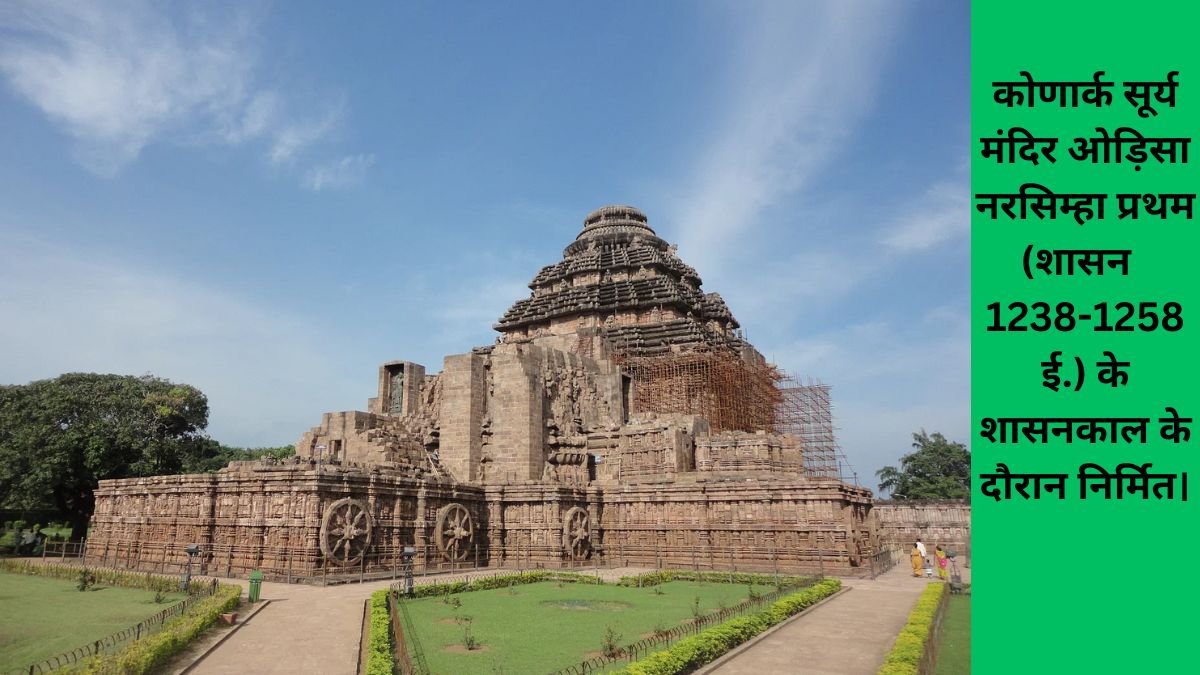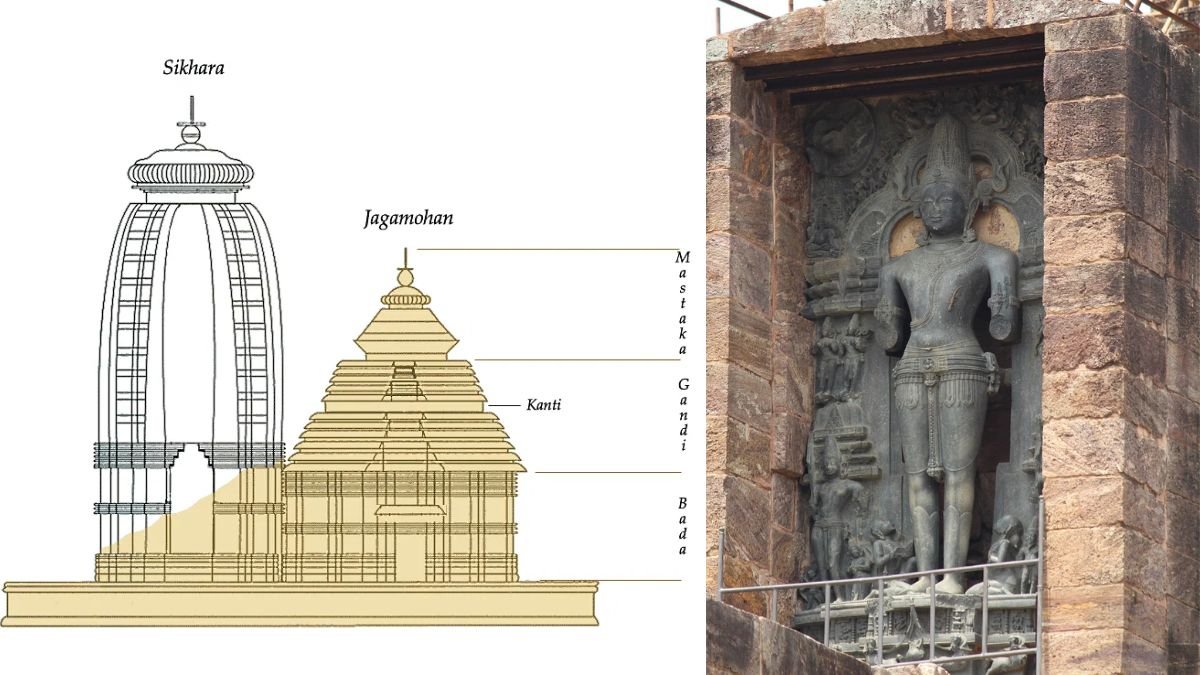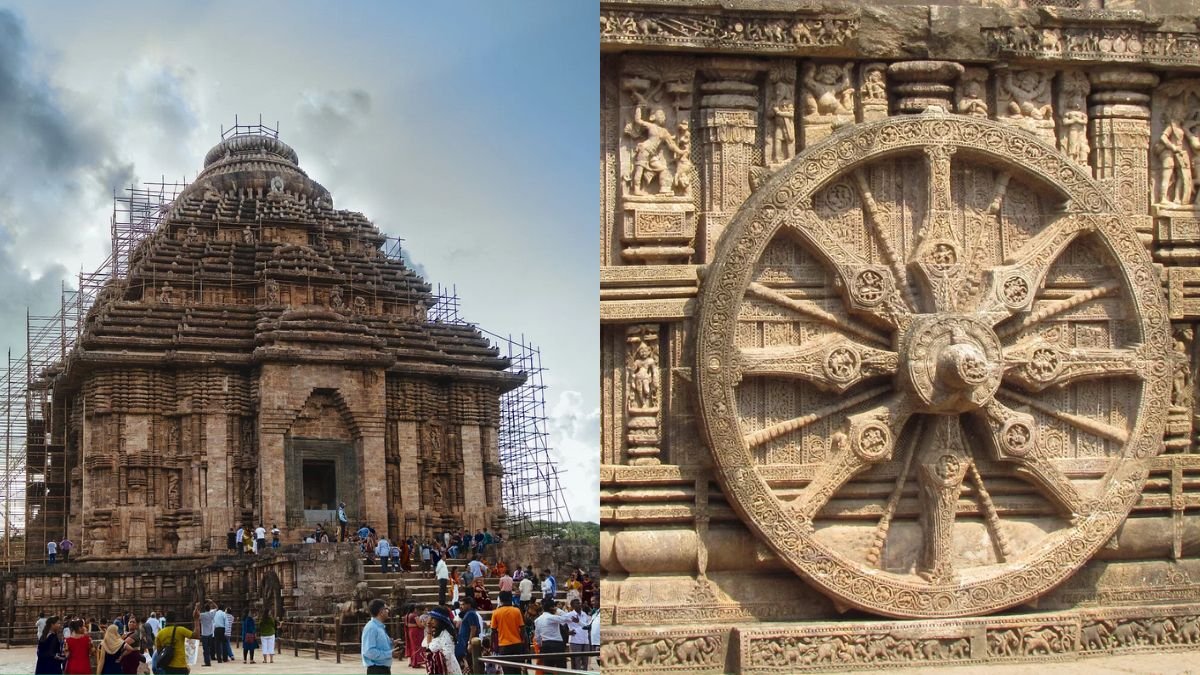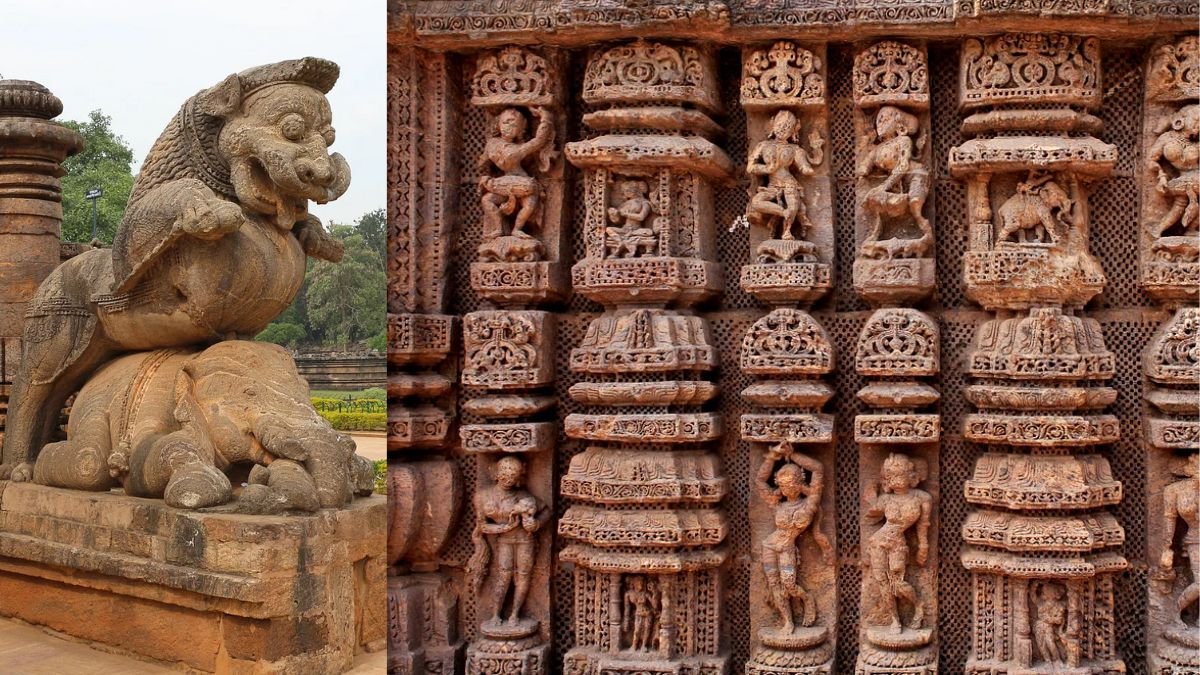
Konark Sun Temple: An Exemplar of Hindu Architectural Splendor
The Konark Sun Temple, a sacred edifice devoted to the Hindu Sun God, is a marvel of ancient Indian architecture. Its grandeur lies in the portrayal of a colossal stone chariot adorned with 12 wheels, symbolizing the celestial vehicle of the Sun, making it one of India’s most renowned Sun temples.
Origin and Builder of the Sun Temple of Konark
Situated approximately 35 km northeast of Puri along the picturesque sea coast of Odisha (formerly Orissa), the Konark Sun Temple was erected in 1250 AD under the patronage of King Narasimhadeva I, a ruler belonging to the esteemed Eastern Ganga Dynasty (8th century – 15th century).
Preservation of Heritage: UNESCO World Heritage Site
Acknowledging its historical and cultural significance, the Konark Sun Temple was officially designated as a UNESCO World Heritage Site in the year 1984 AD. Despite the passage of time and the wear of ages, the temple’s remains continue to draw not only tourists from across the country and around the globe but also devout Hindu pilgrims. Adorned with intricate sculptures and captivating artwork on diverse themes, Konark stands as a splendid exemplar of Hindu temple architecture.
The Eastern Ganga Dynasty and the Architectural Legacy of Odisha
Emerging in the “early eighth century AD,” the Eastern Ganga Dynasty established its dominion in the Kalinga region, which corresponds to present-day Odisha state. Over time, the dynasty’s prominence and territorial expansion burgeoned, particularly from the 11th century AD onward. King Anantavarman Chodaganga, who reigned from 1077 to 1147 AD, reigned as one of the most remarkable monarchs of the dynasty, ruling for nearly seven decades. He was not merely a formidable warrior but also a great patron of the arts, particularly emphasizing the construction of temples.
The illustrious legacy of temple construction initiated by King Chodaganga found its pinnacle in the Jagannath Temple at Puri. This temple, characterized by its artistic vigor and prosperity, became a resplendent monument to Orissa during his reign. Following in his footsteps, his successors continued this architectural tradition, most notably exemplified by King Narasimhadeva I, who oversaw the completion of not only the renowned Jagannath Temple but also the magnificent Sun Temple at Konark.

Architectural Marvel and Features of Konark Temple
The etymology of the term “Konark” reveals its essence, derived from the amalgamation of two Sanskrit words – “Kona” signifying “corner or angle” and “Arka” symbolizing the “sun.” This name aptly reflects the temple’s primary dedication to the Sun God and its distinctive angular design.
Adopting the Kalinga or Orissa style of temple architecture, a sub-style of the Nagara style prevalent in northern India, the Konark Sun Temple exemplifies the purity of the Orissa style. Notably, the Nagara style, one of the three dominant styles of Hindu temple architecture in India, gained prominence in northern regions, whereas the Dravidian style held sway in the south, and the Vesara style in central and eastern India. These architectural styles were discernible through various visual representations, encompassing ground plan and elevation.
Distinctive Features of the Orissa Style
The Orissa style boasts two primary features – the “Deul” or sanctum sanctorum, housing the presiding deity and crowned by a towering “shikhara” (tower), and the “Jaganmohan” or assembly hall. The latter features a pyramidal roof fashioned through a series of receding platforms called “Pidhas.” Both the sanctum sanctorum and assembly hall are square internally and share a common platform.
The exterior facade of the temple is embellished with projections known as “Rathas” or Pagas, skillfully creating a play of light and shadow, adding to the temple’s artistic allure. Numerous temples constructed in the Orissa style exhibit distinct variations, and the Konark Sun Temple serves as an exceptional exemplar in this regard.
Influence of the Khakhra Style
The origins of the Khakhra style, which can be traced back to around 1100 BC in Bhubaneshwar, the capital of present-day Odisha, greatly influenced the architecture of the Lingaraja temple. Locally recognized as the Khakhra style, this architectural approach involved situating the temple within an expansive quadrangular courtyard, encompassed by massive walls with a grand gateway in the east. Apart from the sanctum sanctorum and the imposing high-pillared halls, the temple complex also featured various halls dedicated to diverse activities, including dancing, food service, and gatherings.

A Timeless Marvel of Orissa’s Architectural Movement
Konark, surpassing even the esteemed Lingaraja temple in its conceptualization and perfection, stands as an impressive and grand spectacle. Despite the ravages of time and the temple’s current state of ruin, Konark continues to inspire awe and admiration, exemplifying the culmination of Odisha’s architectural prowess and cultural heritage. As an enduring symbol of Hindu architectural splendor, Konark Sun Temple remains a testament to the magnificence of ancient India’s artistic achievements.
The Magnificent Stone Chariot: The Konark Temple
The Konark temple stands as a grand testament to ancient art and religious beliefs, fashioned entirely from stone, presenting itself in the awe-inspiring form of a colossal chariot dedicated to the Sun God. This architectural marvel features twelve pairs of lavishly adorned wheels, symbolizing the twelve months of the year, skillfully carved on the sides of the “chariot.” Seven powerful horses pull this divine vehicle, reflecting the Hindu tradition that associates Surya, the Sun God, with a celestial chariot drawn by seven horses.
Legend and Mythological Significance:
The origins of Konark’s significance trace back to ancient Hindu texts and sacred scriptures, including the Puranas. Known as Konaditya, this sacred place was considered the holiest site for Sun worship in the region of Odisha. According to the myths, Samba, a son of Lord Krishna, built the temple as an act of gratitude for being cured of a skin ailment by the Sun God. Interestingly, local Brahmins refused to worship the image of Surya, leading Samba to bring sun worshipers from Persia to honor the deity. This story was originally connected to a sun temple in northwestern India but was later moved to Konark, enhancing its sanctity and significance for devotees.
The Royal Dream:
The exact motivation behind the construction of the temple by King Narasimhadeva remains uncertain. Historians speculate that the king might have undertaken this grand project to express his gratitude for a fulfilled wish or to commemorate a military triumph. Alternatively, the temple could be a profound display of the king’s devoutness towards the Sun God, interwoven with his perception of life as a powerful ruler. Evident in the intricate sculptures are depictions of royal activities such as hunting, processions, and military scenes, portraying the Sun Temple as the embodiment of a luminous dream of an ambitious and mighty king, who was equally enthusiastic about secular aspects of life.
Construction and Artistic Marvel:
The temple’s construction utilized three types of stone – Chlorite, Laterite, and Khondalite. Khondalite, although of modest quality, forms the primary material throughout the monument, while Chlorite was reserved for door frames and select sculptures. Laterite was employed for the foundation, the invisible core of the platform, and the stairs. These stones were not locally available, necessitating their transportation from distant regions. Ingenious methods, such as pulleys, wooden wheels, or rollers, were employed to raise and set the stone blocks in place, ensuring seamless joints and impeccable finishing.
Idols and Artistry:
During Narasimhadeva’s reign, the Konark temple attained the zenith of Eastern Ganga art. Sculptors adorned every inch of available space with a diverse array of subjects, including dancers, musicians, and scenes depicting desires and sensual pleasures (kama). The intricate carvings also feature floral and geometric motifs, mythological creatures, birds, and animals.
Notably, the panels depict King Narasimhadeva in various roles: a scholarly figure reviewing literary works presented by poets, enjoying moments on a swing in his palace, showcasing his prowess as an archer, and exemplifying deep religious devotion as a devotee. These panels, crafted from pink and green Khondalite, continue to captivate admirers and can be seen at the National Museum in New Delhi. While these intricate depictions primarily focus on the facets of royal life, they reveal the artistic mastery and grandeur of the Konark temple, leaving a lasting legacy of beauty and devotion.
The Enigmatic Colossus: A Sculpture of Surya Wearing Shoes
The Konark Sun Temple, an architectural marvel dedicated to the Hindu Sun God, houses a remarkable and distinctive sculpture in its southern sanctum. This colossal idol of Surya stands out as one of the few sculptures in India where the Lord is portrayed wearing shoes, a unique and intriguing feature.
Central Asian Influence on Indian Art
The depiction of Surya wearing shoes can be attributed to the influence of Central Asian art on ancient Indian sculptures. This influence was a result of the reign of Scythian-origin dynasties that once ruled parts of ancient India.
Awe-Inspiring Sculptural Details
The awe-inspiring sculpture presents Surya standing on a chariot drawn by seven horses. The entire idol is fashioned from a single piece and stands atop a chlorite pedestal. Measuring 3.38 meters in height, 1.8 meters in width, and 71 centimeters in thickness, the artwork showcases the exquisite craftsmanship of its creators.
The magnificence of Clothing and Jewelry
The Sun God is adorned with a short lower garment (Antariya) draped in a unique style, where one end of the garment is drawn between the legs and tucked behind the waist. The sculpture also showcases an array of intricate ornaments, including a waist girdle, a necklace composed of five beaded cords with a central clasp, armlets, earrings, and a crown. Each bead and motif is meticulously engraved, resulting in a breathtaking display of artistry.
Halo and Lotus Stalks
A radiant halo encircles Surya’s head, with flames emanating outward, symbolizing his divine brilliance. The idol’s hands hold lotus stalks, further accentuating the divine symbolism associated with the Sun God.
Surrounded by Divine Dancers and Worshipers
The sculpture is accompanied by a multitude of subsidiary figures, including divine dancers and a king worshiping alongside his family priest, adding to the artistic and spiritual richness of the temple.
Guardians of the Temple: Lions, Elephants, and War Horses
To safeguard the temple’s verandah, masterpieces of sculptural art from the Odisha region were installed. These include pairs of colossal lions standing on reclining elephants in the east, richly decorated and harnessed elephants in the north, and beautifully adorned war horses in the south.

The Fate of Konark: From Fame to Fall
During the medieval period, Konark Sun Temple gained fame and found mention in literary works. It served as a landmark for sailors navigating the Bay of Bengal, along with the renowned Jagannath Temple. The early European travelers dubbed the Jagannath Temple the “White Pagoda” and the Konark Sun Temple the “Black Pagoda,” owing to their plaster color, which has since been removed after restoration efforts.
Unraveling the Mystery of Collapse
The temple’s “Deul” (tower) and “Shikhar” (spire) eventually collapsed, with the exact reasons remaining uncertain. Some theories suggest that the foundation sank, while others attribute it to an earthquake or lightning. Additionally, questions have been raised about whether the temple was ever fully completed. The extensive use of poor-quality Khondalite is also believed to have contributed to the temple’s gradual decay. Some historians associate the onset of this decline with the impact of Islamic invasions on the region.
The Loss of the Presiding Deity
Adding to the temple’s enigma, the image of the presiding deity, Surya, has never been found. Speculations range from its destruction to its possible removal from the Jagannath temple. The loss of the deity led to neglect and eventual decay of the temple complex.
Revival Efforts and Preservation
In the 19th century, James Ferguson, a renowned Scottish historian, contributed to rediscovering ancient Indian antiquities, including Konark. Preservation efforts began to gain momentum in the early 20th century, with the Archaeological Survey of India undertaking the responsibility of conserving and maintaining this invaluable heritage site since 1939.
The Konark Sun Temple continues to captivate visitors with its intricate sculptures, inspiring reverence for the artistry and spirituality it embodies. As an enduring symbol of India’s rich cultural legacy, this temple stands as a testament to the ingenuity and craftsmanship of ancient Indian artists and architects.
The Magnificent Legacy of Konark Sun Temple
Konark Sun Temple stands as a grand testament to the opulence and extravagance of princely life during its time. It exudes an aura of luxury and grandeur that prevailed in the royal surroundings of that era. The temple appears to be the embodiment of a king’s dream, where he sought to etch his name and secular accomplishments in eternity while also expressing his devotion as a devout Indian monarch.
The artisans who crafted this architectural wonder skillfully portrayed both the secular and religious aspects. While showcasing the king’s worldly pursuits, they also captured the essence of his religious fervor. As a result, the Konark temple remains an extraordinary fusion of worldly and spiritual aspirations.
Even in its current state of ruin, the temple stands majestically, serving as a living witness to the architectural and artistic brilliance of medieval Odisha and India at large. The construction of the temple continued a rich tradition of temple architecture that originated during the Gupta period (3rd century CE to 6th century CE), spanning centuries of artistic evolution.
For enthusiasts and scholars of art, architecture, history, and archaeology, Konark is a treasure trove of knowledge and insights. It offers a captivating window into the cultural heritage of India, providing valuable lessons and inspiration for generations to come.
Today, Konark Sun Temple remains an alluring destination not only for tourists and pilgrims but also as a vibrant venue for cultural festivals and captivating classical Indian dance performances. Its continued significance in modern times reflects its pivotal role in preserving and perpetuating India’s rich cultural legacy.
As the glorious rays of the Sun God continue to bathe this timeless masterpiece, Konark Sun Temple stands tall, weaving the threads of history, spirituality, and cultural heritage into an awe-inspiring tapestry for the world to behold.